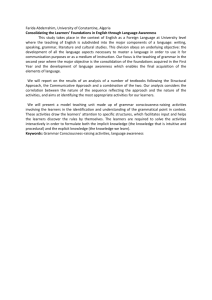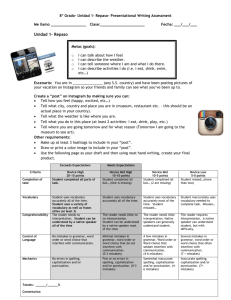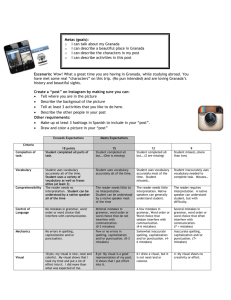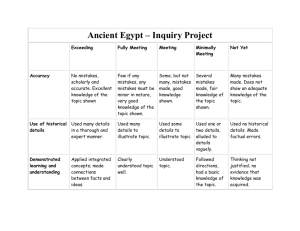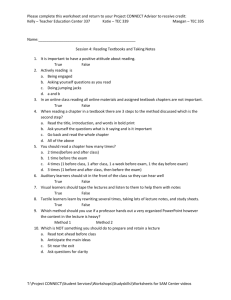Teaching writing
advertisement
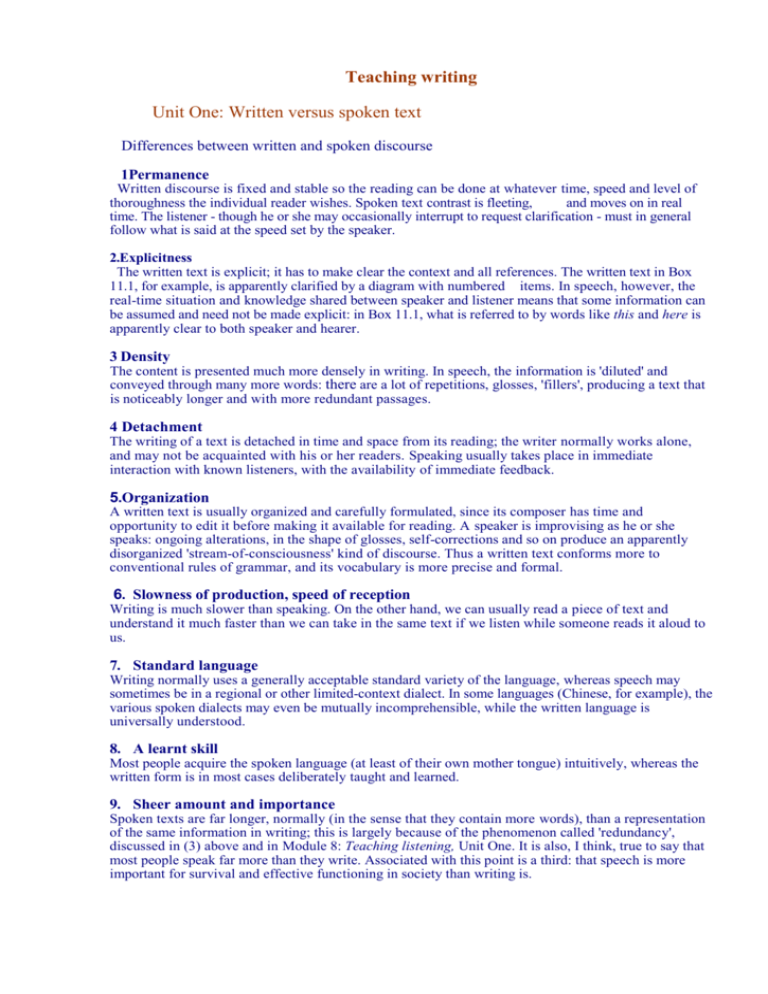
Teaching writing Unit One: Written versus spoken text Differences between written and spoken discourse 1Permanence Written discourse is fixed and stable so the reading can be done at whatever time, speed and level of thoroughness the individual reader wishes. Spoken text contrast is fleeting, and moves on in real time. The listener - though he or she may occasionally interrupt to request clarification - must in general follow what is said at the speed set by the speaker. 2.Explicitness The written text is explicit; it has to make clear the context and all references. The written text in Box 11.1, for example, is apparently clarified by a diagram with numbered items. In speech, however, the real-time situation and knowledge shared between speaker and listener means that some information can be assumed and need not be made explicit: in Box 11.1, what is referred to by words like this and here is apparently clear to both speaker and hearer. 3 Density The content is presented much more densely in writing. In speech, the information is 'diluted' and conveyed through many more words: there are a lot of repetitions, glosses, 'fillers', producing a text that is noticeably longer and with more redundant passages. 4 Detachment The writing of a text is detached in time and space from its reading; the writer normally works alone, and may not be acquainted with his or her readers. Speaking usually takes place in immediate interaction with known listeners, with the availability of immediate feedback. 5.Organization A written text is usually organized and carefully formulated, since its composer has time and opportunity to edit it before making it available for reading. A speaker is improvising as he or she speaks: ongoing alterations, in the shape of glosses, self-corrections and so on produce an apparently disorganized 'stream-of-consciousness' kind of discourse. Thus a written text conforms more to conventional rules of grammar, and its vocabulary is more precise and formal. 6. Slowness of production, speed of reception Writing is much slower than speaking. On the other hand, we can usually read a piece of text and understand it much faster than we can take in the same text if we listen while someone reads it aloud to us. 7. Standard language Writing normally uses a generally acceptable standard variety of the language, whereas speech may sometimes be in a regional or other limited-context dialect. In some languages (Chinese, for example), the various spoken dialects may even be mutually incomprehensible, while the written language is universally understood. 8. A learnt skill Most people acquire the spoken language (at least of their own mother tongue) intuitively, whereas the written form is in most cases deliberately taught and learned. 9. Sheer amount and importance Spoken texts are far longer, normally (in the sense that they contain more words), than a representation of the same information in writing; this is largely because of the phenomenon called 'redundancy', discussed in (3) above and in Module 8: Teaching listening, Unit One. It is also, I think, true to say that most people speak far more than they write. Associated with this point is a third: that speech is more important for survival and effective functioning in society than writing is. Unit Two: Teaching procedures This unit studies the objectives and content of textbook procedures that teach writing: what is, or should be, their content? We shall look at some writing tasks and examine what each in fact does for the learner. First, does it really teach writing, or just use writing as a means to teach some other aspect of language (grammar, for example)? Second, if it does focus on writing itself, what sort of a balance does it maintain between 'micro' aspects (spelling, punctuation, etc.) and 'macro' (content, organization)? Writing as a means or as an end 1. As a means Writing is widely used within foreign language courses as a convenient means for engaging with aspects of language other than the writing itself. For example: learners note down new vocabulary; copy out grammar rules; write out answers to reading or listening comprehension questions; do written tests. In these examples, writing is simply used either as a means of getting the students to attend to and practise a particular language point, or — even more frequently -as a convenient method of testing it: providing information as to how well something has been learned in a form which the teacher can then check at his or her leisure. 2. As an end Other activities take as their main objective the writing itself. At the 'micro' level they practise specific written forms at the level of word or sentence (handwriting or typing, spelling, punctuation); at the 'macro' level the emphasis is on content and organization: tasks invite learners to express themselves using their own words, state a purpose for writing, and often specify an audience. Examples of such activities would be: narrating a story, writing a letter. 3. As both means and end A third kind of activity combines purposeful and original writing with the learning or practice of some other skill or content. For example, a written response to the reading of a controversial newspaper article (combines writing with reading); the writing of anecdotes to illustrate the meaning of idioms (combines writing with vocabulary practice). Writing for content and/or form The purpose of writing, in principle, is the expression of ideas, the conveying of a message to the reader; so the ideas themselves should arguably be seen as the most important aspect of the writing. On the other hand, the writer needs also to pay some attention to formal aspects: neat handwriting, correct spelling and punctuation, as well as acceptable grammar and careful selection of vocabulary. This is because much higher standards of language are normally demanded in writing than in speech: more careful constructions, more precise and varied vocabulary, more correctness of expression in general. Also, the slow and reflective nature of the process of writing in itself enables the writer to devote time and attention to formal aspects during the process of production -something it is difficult to demand in the course of the real-time flow of speech. One of our problems in teaching writing is to maintain a fair balance between content and form when defining our requirements and assessing. What this 'fair balance' is depends, of course, to some extent on your own teaching situation and opinion. Unit Three: Tasks that stimulate writing Tasks given in textbooks to stimulate writing do not always do so very effectively. Some criteria for the evaluation of textbook writing activities 1. Would my students find the activity motivating and interesting to do? 2. Is it of an appropriate level for them? Or would they find it too easy/difficult/ childish/sophisticated? 3. Is the kind of writing relevant to their needs? 4. Would I need to do some preliminary teaching in preparation for this activity? 5. In general, do I like this activity? Would I use it? Cambridge University Press 1996 In box 11.4 are some writing activities of types commonly found in coursebooks. Study the list of activities and the list of comments. BOX 11.4; SOME TEXTBOOK WRITING ACTIVITIES 1. Write a report of a book you have just read. 2. Write a review of a book you enjoyed and would like to recommend to other people in the class. 3. Write an instruction sheet for something you yourself know how to do well (e.g. prepare some kind of food). 4. Write a narrative based on a picture or series of pictures. 5. Describe an occasion when you were disappointed (or afraid, surprised, relieved ...). 6. Look out of the window, and describe the view you see. 7. Describe someone you know very well. 8. Write imaginary descriptions of five people, based on photographs and some information about their professions. 9. Write an answer to a (given) letter of complaint. 10. Write a letter applying for a job as babysitter, stating your qualifications for the job. 11. Think of a change you would like to see introduced in your country, home community or place of work/study. Write a recommendation to the authorities, explaining why it is desirable and suggesting how it might be effected. 12. Read a newspaper article reporting a piece of news, and notice the kinds of information provided. Write a similar article of your own on an imaginary event. 13. Imagine your ideal school. Describe it. 14. Describe the process represented in a flowchart or other kind of diagram. 15. Listen to a piece of music. Describe the plot and atmosphere of the film for which it is to be the background music. Cambridge University Press 1995 Comments: Writing tasks 1. Book report Can be a fairly routine, rather boring, exercise; usually done in order to check that students have read a book, rather than for the sake of the writing. Some preliminary guidance is sometimes needed on content and organization. 2. Book review About the same level as (1), also needing some preliminary guidance; but the writing is more purposeful, audience-oriented and interesting to do. There is some point in rewriting and polishing the reviews for publishing within the class. 3. Instruction sheet Students usually find this interesting to do, and a little easier than (1) and (2). You may wish to give some advice on the layout of instructions. 4. Narrative A fairly interesting task that can be adapted for most levels. It does depend on preparation of suitable pictures, perhaps cut from magazines. 5.Personal story On the whole students are motivated to write (and read) about personal experiences; also, each can write at his or her own level of proficiency. Preparation: perhaps a brief sample of a personal story contributed by the teacher or a volunteer student. 6.Describe a view This can be interesting, but should be kept fairly short; it can be done at various levels of proficiency. If no window with a view is available, students can be asked to recall and describe a view they are familiar with. 7.Describe someone Fairly easy to do, and straightforward to present; can be interesting both to write and read. 8.Describe people Of about the same level as (7); can also be interesting, because of the stimulus to the imagination - but of course demands more preparation. 9.Answer a letter Usually a highly motivating task, fairly advanced, with a clear audience and purpose. As it stands, you need to prepare the original letter; an alternative is to ask all the students to write letters of complaint, and later answer each other's letters. Some pre-teaching of conventional letter formalities and layout in the target language is necessary. 10.Job application Again, some conventions about letters like this will need to be taught, and perhaps some details about the exact job being applied for. 11.Propose change Advanced writing, involving the organized and convincing presentation of an argument. You may or may not feel it necessary to read a similar piece of writing with the students in advance, to supply a model. 12.News report This is clear 'model-imitation' writing, which is perhaps useful, but not very interesting to do. It may be more interesting if it is a report of a genuine local event. In preparation, you may need to draw learners' attention to the typical features of this genre of written discourse. 13.Ideal school A task which is interesting and relevant for schoolchildren. Little preparation is necessary, apart from, perhaps, some preliminary brainstorming of the kinds of topics they may wish to include. 14.Describe process A more sophisticated task, requiring precise and orderly representation of facts: suitable particularly for learners in science or technology. 15.Film music A stimulating, fun task for imaginative students, but it may take time to select and prepare a suitable piece of music. The writing process: Summary and implications for teaching 1. Individuals vary. Different writers may produce equally good results through widely different processes. This means that there is probably no one 'right' system of writing that we should recommend; rather, we should suggest and make available various possible strategies, encouraging individuals to experiment and search for one that is personally effective. 2. Writing is a messy business. Most people progress through a number of untidy drafts before reaching a final version. Nor do they always follow what might seem a rational order of priority: it is true that on the whole good writers think about content first and form later, but this order is not consistently observed. Actual content may be altered at quite late stages in the drafting, and changes to sentence or paragraph organization relatively early. So while it may be useful to advise learners not to worry too much about spelling and grammar at the beginning, and to get down their ideas first, it may not be wise to try to impose this as a rigid rule. More helpful, perhaps, is to encourage learners to work through a number of revisions; to accept messy drafts as a positive, even essential, stage in writing; to treat early drafts as transition stages to be criticized but not formally assessed. 3. Writing is potentially satisfying. If you are writing on a topic about which you feel you have something worthwhile or interesting to say, the process of writing can be absorbing and enjoyable; and if it is worked through to a final product, most people feel pride in their work and want it to be read. It is therefore worth investing thought in the selection of topics and tasks that motivate learners to write; and extremely important to provide an appreciative reader audience, whether teacher or co-learners. 4. You learn to write through writing. This may seem obvious - the same can be said of all the other skills - nevertheless it needs to be emphasized. Reading, of course, helps, since it familiarizes learners with the conventions governing various kinds of texts and in general improves their language, but it is not enough, and is no substitute for hands-on writing experience. One of our main tasks then, as teachers, is to get our students to write a lot, thinking as they do so and learning from their own writing experience. Postscript: The problems themselves Problem 1 With a class such as that described here I would do less writing than with other classes, but I would still do some, for two main reasons. First, neither we nor our students can be quite sure about the future, and some of the students might find themselves in a situation where they do need to write. Second, I believe that learning how to write effectively has value in itself as part of the long-term education process, and should not be evaluated only on whether it is immediately profitable or not. Problem 2 The two suggestions at the end of this 'problem' can both contribute to solving it. We can certainly decide to correct only the more basic or serious mistakes in order to lessen the discouraging effect of too many corrections. And we can partially control student writing by, for example, giving a part of what they are to write ready-formulated in advance; or by prescribing certain limits or frameworks. But to overcontrol writing so that there are few or no mistakes would, I feel, be a pity; students should have opportunities to spread their wings and be ambitious. Our responses to free writing, even if this is full of mistakes, can mitigate discouragement and encourage learning: we can, for example, draw students' attention in our feedback to things they have got right as well as things they have got wrong; and we can even explain frankly that writing-with-mistakes is not something to be ashamed of but rather a helpful and important stage in learning - which it is. Unit Four: Giving feedback on writing This unit describes various problems associated with the giving of feedback on original writing in the foreign language, and gives some advice as to how to deal with them. 1. What should feedback be mainly on: language? Content? Organization? The problem When a student submits a piece of original writing, the most important thing about it is, arguably, its content: whether the ideas or events that were written about were significant and interesting. Then there is the organization and presentation: whether the ideas were arranged in a way that was easy to follow and pleasing to read. Finally, there is the question of language forms: whether the grammar, vocabulary, spelling and punctuation were of an acceptable standard of accuracy. Many teachers are aware that content and organization are important, but find themselves relating mainly to language forms in their feedback, conveying the implicit message that these are what matters. This is for various reasons: 1. Mistakes in spelling or grammar catch the eye and seem to demand to be corrected; they are very difficult to ignore. 2. Students also want their language mistakes to be corrected. (Ask them! And see Leki, 1991.) 3. Language mistakes are far more easily and quickly diagnosed and corrected than ones of content and organization. Advice We should, I think, correct language mistakes; our problem is how to do so without conveying the message that these are the only, or main, basis for evaluation of a piece of writing. One possibility is to note corrections within the body of the text, and devote comments at the end to matters of content and organization, followed by the evaluation. Alternatively, we may correct mistakes and make suggestions as to content and organization, but not evaluate; and give the evaluation only on the basis of the rewritten, polished version. 2. Should all mistakes be corrected? The problem If we accept that language (including punctuation) should be corrected, another problem arises: should all language mistakes be noted, even if there are so many that the page will be covered with corrections? If not, how do we judge which to relate to and which not? Advice The problem is one of potential conflict between two of our functions as teachers: language instruction versus support and encouragement of learning. The correcting of mistakes is part of the language instruction, but too much of it can be discouraging and demoralizing. Also, over-emphasis on language mistakes can distract both learners' and teachers' attention from the equally important aspects of content and organization. Some kind of compromise is obviously called for, which will vary according to context. In principle, it would seem reasonable to say that language mistakes should be ignored if there is a danger that to correct them would hinder learning more than help it. We might correct only mistakes that actually affect meaning (that is, might lead to misunderstanding or confusion on the part of the reader), and/or those which are very basic; or, of course, vary our response according to individual need. 3.Should learners rewrite, incorporating corrections? The problem When we receive written work, we normally correct and comment on it and give it back. The question is whether to insist on the students rewriting the compositions, incorporating our suggestions for improvements. This can be tedious, and students do not like doing it; on the other hand, it does probably help to reinforce learning of the correct forms. Advice I think rewriting is very important: not only because it reinforces learning, but also because rewriting is an integral part of the writing process as a whole. However, if we demand rewriting on the part of the students, they have a right to demand from us that we reread - and value - what they have done. It makes sense to see the first version as provisional, and to regard the rewritten, final version as 'the' assignment, the one that is submitted for formal assessment. This helps to motivate learners to rewrite and to appreciate the value of doing so. 4.Should we let students correct or give feedback on each other's written work? The problem Correcting written work is very time-consuming, particularly if we have large classes. One possible solution is to let students correct and edit each other's writing. They may not be able to see or define all the good qualities or shortcomings of an assignment, but they will detect at least some of them. The problem is: will students feel uncomfortable correcting, or being corrected by, their peers? Will they accept criticism (positive or negative) from each other? Advice In general, yes, peer-correction can be a time-saving and useful technique; also, critical reading for style, content and language accuracy is a valuable exercise in itself. This does not release us from the duty of checking and evaluating student writing; but it can be a substitute for first-draft reading. Students can work together on their first drafts, giving each other feedback on content, language and organization; they then rewrite and give in the final version to the teacher. The question of personal relationships, trust and willingness to accept criticism and help from one another remains. This is not a problem that can be solved by particular teaching techniques; it depends on the general classroom climate, which in its turn is created by the attitudes of both students and teachers. Further reading BACKGROUND Freedman, A., Pringle, I. and Yalden, J. (eds.) (1983) Learning to Write: First Language/Second Language, London: Longman. (A series of articles on various aspects of learning to write: accounts of research, discussions of problems) Hedge, T. (1988) Writing, Oxford: Oxford University Press. (A summary of some main issues, followed by discussion of the teaching of various types and levels of writing, with plenty of illustrative tasks) Kroll, B. (ed.) (1990) Second Language Writing, Cambridge: Cambridge University Press. (A collection of research-based articles: relates mainly to writing done by fairly advanced adult learners) Leki, I. (1991) 'Teaching second language writing; where we seem to be', English Teaching Forum, 29, 2, 8-11, 26. (A brief, readable overview of issues in the teaching of writing) Smith, F. (1982) Writing and the Writer, London: Heinemann. (On the process of (first-language) writing in general; informal, readable) Tannen, D. (1982) 'Oral and literate strategies in spoken and written narrative', Language 58,1,1-21. (On the differences between 'autonomous' and 'non-autonomous' text, as distinct from the written/spoken dichotomy) TEACHER'S HANDBOOKS Byrne, D. (1988) Teaching Writing Skills (2nd edn.), London: Longman. (A guide to teaching writing from early to advanced stages; plenty of practical teaching ideas) Raimes, A. (1983) Techniques in Teaching Writing, Oxford: Oxford University Press. (A simple exposition of a number of varied techniques, mainly focusses on production of acceptable written language forms) White, R. V. (1980) Teaching Written English, London: Heinemann Educational Books. (A readable, not too long introduction to the basics of the topic) White, R. V. and Arndt, V. (1992) Process Writing, London: Longman. (Discusses various strategies and techniques used during the writing process, and suggests appropriate teaching procedures) Ресурс – Ur Penny, A Course of Language Teaching, CUP, 2008 – 373.


